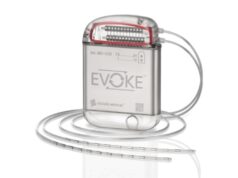
The US Food and Drug Administration (FDA) has approved BurstDR stimulation, a physician-designed form of spinal cord stimulation (SCS) clinically proven to provide superior outcomes for patients with chronic pain over traditional SCS therapy.
According to the manufacturer (St Jude Medical), BurstDR stimulation has been clinically proven to improve upon traditional SCS by generating superior pain relief. With BurstDR stimulation, St Jude Medical is also helping physicians address their patients’ physical and emotional responses to pain and reduce overall pain and suffering as measured by patients who reported their responses to therapy with BurstDR stimulation through visual analogue scale (VAS) scoring.
“As a physician, reducing the physical sensation of pain experienced by my patients is only part of my job; my ultimate goal is to help patients overcome both the physical pain and the suffering associated with their pain,” says Timothy R Deer, president and chief executive officer of The Center for Pain Relief in Charleston, USA. “Now, with BurstDR stimulation, St Jude Medical has armed physicians with a new therapy option that can reduce patients’ pain and suffering, reduce paraesthesia and help us offer our patients a more complete pain management option.”
A company press release explains that St Jude Medical’s proprietary BurstDR stimulation works differently from other stimulation designs, utilising intermittent “burst” pulses designed to mimic the body’s natural nerve impulse patterns. While other companies have tried to mimic burst patterns, BurstDR stimulation from St Jude Medical is the only approved form of burst stimulation to have been evaluated in a large scale, multicentre randomised controlled clinical trial.
The St Jude Medical BurstDR stimulation was introduced after nearly a decade of research and study in collaboration with Prof Dirk De Ridder, who filed the therapy’s initial patents in 2004. BurstDR stimulation was evaluated within the SUNBURST study, a prospective, randomised multicentre study which confirmed BurstDR stimulation offered superior pain relief over traditional SCS and that the therapy was preferred by most patients over traditional SCS therapy. In addition, BurstDR stimulation has been studied in a large number of international real world studies that have helped the company assess the benefits of the therapy in patients worldwide.
“I am very excited that patients across the United States will now have access to BurstDR stimulation, which has enjoyed strong success across other global markets,” said Prof De Ridder, from the University of Otago in Dunedin, New Zealand. “When I developed BurstDR stimulation my goal was to introduce an entirely new therapy option, and one that was rooted in the natural way in which the human body responds to and combats the sensation of pain.”
With FDA approval of BurstDR stimulation, patients receiving new implants of the St Jude Medical Proclaim Elite and Prodigy MRI spinal cord stimulation systems will have immediate access to the new therapy. Combined, the Proclaim Elite SCS System and BurstDR stimulation offers patients the advantages of the St Jude Medical Invisible Therapy portfolio and an entirely recharge free option, allowing patients to focus on their lives instead of their pain. In addition, patients previously implanted with upgradeable Protégé and Proclaim SCS systems will soon be able to upgrade their systems to deliver BurstDR stimulation without additional surgery.
“Chronic pain is one of the most costly epidemic diseases facing healthcare systems worldwide, and one of the most challenging for physicians to manage due to the complexity of the condition and the differences in each patient’s clinical case,” says Allen W Burton, medical director of neuromodulation and vice president of medical affairs at St Jude Medical. “With FDA approval of BurstDR stimulation, we are empowering physicians with a new therapy option in their fight against widespread chronic pain, and our goal is to continue to improve patient outcomes and get more patients the pain relief they deserve.”












